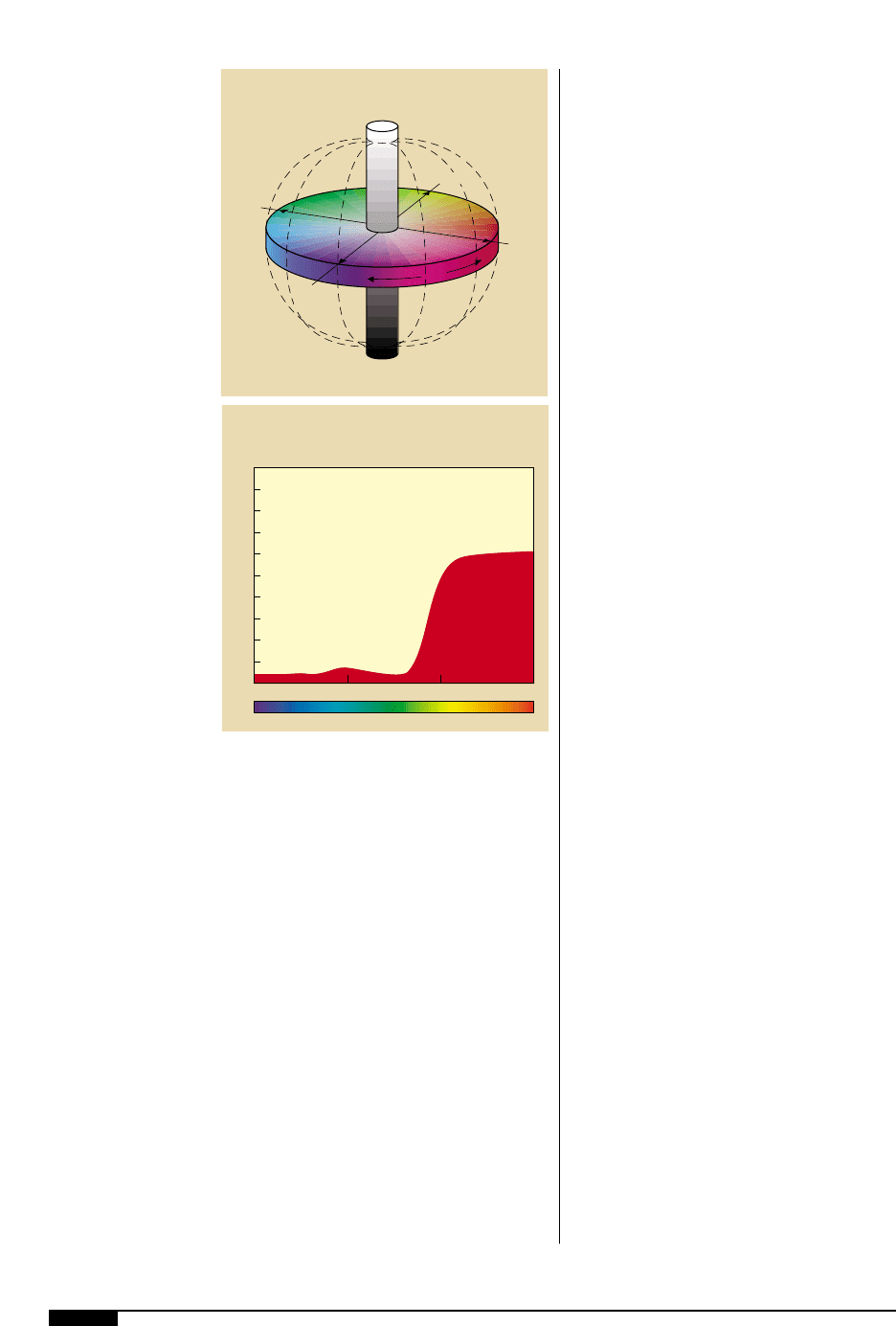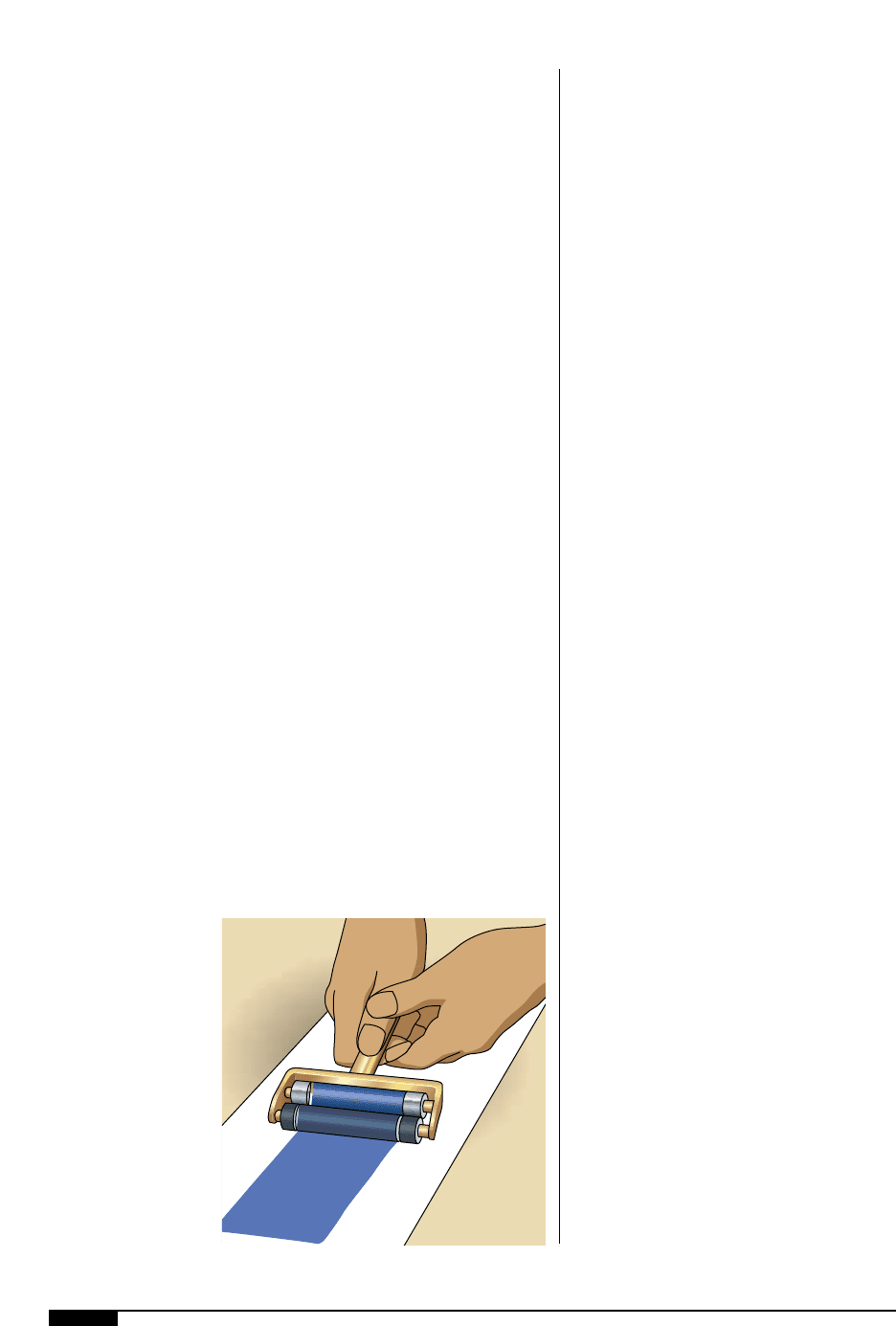FTA (изд-во). Flexography: Principles And Practices. Vol.1-6
Подождите немного. Документ загружается.


22 FLEXOGRAPHY: PRINCIPLES & PRACTICES
sodium, fluorescent, halogen and mercury
vapor, emit visible light with different wave-
length compositions. The lack of certain
wavelengths or parts of the spectrum means
that these light sources can display color.
Consider a sodium lamp: light from this
lamp is pure yellow and contains no blue
component. Therefore articles which appear
blue (absorbing red and green wavelengths)
in normal daylight appear almost black
under a sodium lamp. Although this is an
extreme example, it illustrates the need to
view all colors under identical, specified
light sources for color matching purposes.
The visual characteristics of an ink are
recognized in terms of its color and can be
defined by three independent variables: hue,
saturation, and lightness. Hue (H) actually
describes the color, for example, yellow, red,
or green. These “hues” can be arranged in a
“color circle” (Figure
2%
). Saturation or
chroma (C) refers to the intensity and
strength of the color, with the strongest,
most saturated colors being on the periphery
of the circle.
Lightness (L) represents purity, or how
light/dark the color is, and is indicated on
the z axis. This “map” or color space pro-
vides the ability to specify colors in numeri-
cal terms (L,C,H) which can be accurately
measured using a spectrophotometer. This
device is much more sensitive than the
human eye and can be used to measure the
absorption spectrum of an object by illumi-
nating it with a standard light source of
known intensity and measuring the intensi-
ties of the various wavelengths reflected.
The equipment can then plot a graph of
wavelength vs. percent reflectance to give a
spectral or color curve (Figure
2^
) that rep-
resents the color of the object. This curve
can then be used as a standard when trying
to match the color.
Colorants
Pigments together with dyestuffs, provide
the color or visual identity of an ink and rep-
resent the largest share of the total cost. They
are present to provide both decorative and
functional properties: for example, lightfast-
ness, opacity/transparency and product resis-
tance. Both types of colorants are chemical
compounds that alter appearance by the
selective absorption and/or reflection of light
energy. For organic pigments and dyes, this is
determined by specific groups of atoms,
called chromophores (C=C, C=O, C=N,
N=N), present within the molecules which
absorb light energy. Different combinations
of chromophores absorb different levels of
energy, thereby producing different observed
colors. Other chemical groups, known as aux-
ochromes (OH, Cl, Br, NH2 , CH3), while not
responsible for selective absorption, help
2%
Hues can be arranged in
a “color circle”. This
“map” or color space
provides the ability to
specify colors in
numerical terms (L,C,h),
which can be accurately
measured using a
spectrophotometer.
2^
A graph can be plotted
of wavelength vs. per-
cent reflectance to give
a spectral or color curve
that represents the color
of the object. This curve
can then be used as a
standard when trying to
match that color.
+a
Red
+b
Yellow
L=100
White
L=0
Black
Hue
-a
Green
-b
Blue
2%
400 500 600 700
100
90
80
70
60
50
40
30
20
10
Wavelength (nm)
Reflectance(%)
2^

enhance the effects. Processing conditions
during pigment manufacture and subsequent
chemical treatments also affect the observed
colors. The color of inorganic pigments is
also a function of chemical composition and
oxidation state, and is influenced by the crys-
tal form of the substance.
A pigment is largely insoluble in the ink
media, requiring it to be dispersed, while
dyestuffs are soluble in the vehicle system.
Along with this solubility difference, there
are other basic variations between pigments
and dyes as listed in Table 2. Clearly, the
properties required of the ink and finished
product dictate the colorant used.
Dyes
The dyes used in flexographic printing fall
into four categories:
Solvent Soluble. Solubility in a range of
organic solvent is a typical physical charac-
teristic of solvent-soluble dies. These dyes
often contain the heavy metals Chromium
and Cobalt, which lead to environmental,
health and safety concerns. Used for their
purity of shade and transparency on foil
coatings, they have better lightfastness than
the basic dyes.
Basic or Cationic Dyes. Although they show
high color intensity, brilliancy and solubility
in blends of alcohols and water, the use of
cationic dyes in the flexo industry has
decreased because of toxicity concerns.
These dyes are often used in conjunction
with mordants or fixative agents, such as tan-
nic acid, to improve physical properties like
water resistance and lightfastness. These
dies are suitable only for short-term use on
paper with minimal-resistance requirements.
They still remain the primary components
for the triarylmethane pigment range.
Disperse Dyes. The primary use of disperse
dyes in the printing industry is in heat-trans-
fer inks for printing on textiles. After disper-
sal in a flexographic vehicle, the dye-based
ink is printed on paper. The printed image is
brought into contact with the fabric under
conditions of high heat and pressure. The
dye sublimes, penetrating the fabric where it
condenses, giving bright saturated colors.
Acid Dyes. Acid dyes have a strong affinity for
cellulosic materials and are used for water-
based fugitive check inks, invisible inks in
painting books, and in dyeing paper. Primarily
soluble in water, they give bright hues with
light-fastness ranging from very poor to good.
Pigments
There are numerous different types of pig-
ments. Some are available naturally, primari-
ly as minerals, but the majority are synthetic,
meaning that they are generated from petro-
INK 23
Table 2
PROPERTIES DYES PIGMENTS
■Color Strong, vivid and clean Weak to strong, dirty to clean
■Lightfastness Poor Fair to excellent
■Bleed Resistance Poor Fair to excellent
■Chemical Resistance Poor Fair to excellent
■Heat Resistance Poor to fair Fair to excellent
■Optics Very transparent Opaque to transparent
■Rheology Excellent Poor to good
■Toxicity Fair (except FC&D dyes) Fair to very good
PIGMENT AND DYE VARIATIONS

24 FLEXOGRAPHY: PRINCIPLES & PRACTICES
leum feedstocks. A simple, though imperfect,
way to classify them is as organic and inor-
ganic pigments.
Organic pigments are those derived from
carbon-based materials, while inorganic pig-
ments are compounds of various metals
which contain no carbon atoms with the
exception of carbon black. Although there
are numerous types of pigments, few find
their way into ink formulas. Many are uneco-
nomical, do not provide the necessary resis-
tance or performance properties, or have
associated environmental or toxicity hazards
which preclude their use in flexographic inks.
The following section is a detailed descrip-
tion of the most commonly used pigments
within the industry. Each pigment can be
identified by names in common use, togeth-
er with the appropriate color index number.
(The Color Index is a method devised by the
Society of Dyeists and Colorists for classify-
ing pigments based on their chemical type
and structure). Miscellaneous materials in-
cluding metallic powders, pearlescents, fluo-
rescents and specialty pigments are covered
separately.
Inorganic Pigments
With a few minor exceptions, inorganic
pigments have certain notable features.
These include: high lightfastness, economy,
high opacity, weak tinctorial strength, high
specific gravity and a lack of cleanliness of
hue. Toxicity is also a common feature asso-
ciated with inorganic pigments that contain
harmful metals such as cadmium, lead,
chrome and molybdenum. Inorganic pig-
ments commonly used in flexographic inks
include: titanium dioxide, carbon blacks,
iron blues, iron oxides and extenders such as
calcium carbonate, silica, lithopone and clay.
Titanium Dioxide. This is the most important
white pigment (PW 6) in use today due to its
chemical inertness. A variety of grades are
available. The different grades are surface
treated with coatings of silicon oxides, zirco-
nium, aluminum, zinc, or organic chemicals
to aid dispersion, maximize opacity or gloss
and improve durability. There are two major
crystal forms: anatase and rutile. The rutile
grade is more opaque, but slightly more abra-
sive and yellow than the anatase grades.
Most grades are produced using the chlo-
ride process, rather than the environmental-
ly unfriendly sulfate process. The chloride
process generates a harder crystal structure
with higher dry brightness. The anatase
grade is preferred in situations where doctor
blade, cylinder or die blade wear is a prob-
lem. A dispersed particle size of approxi-
mately 0.2 microns is necessary to achieve
optimal light scattering.
Carbon Blacks. These pigments have an
extremely fine particle size with a high sur-
face area, which can cause body and flow
problems. Like titanium dioxide, they show
outstanding chemical inertness, being
extremely resistant to acids, alkalis, light,
heat and solvents. Almost all grades of carbon
black (PBk. 7) available are produced by the
furnace process. Such furnace grades often
undergo further chemical processing with
oxygen and surfactants to mimic the superior
wetting and flow of the now virtually defunct
channel blacks.
Iron Blues. Also known as Milori, Bronze,
Chinese, or Prussian Blue (PB 27), iron blues
range in shade from a dirty reddish tone to a
cleaner green shade and can show consider-
able bronzing. These pigments show excel-
lent resistance to solvents, fats and light
(except tints with titanium dioxide), but are
difficult to grind. They have poor alkali resis-
tance and are unsuitable for use in water-
based systems or for use on soap wrappers.
These pigments should not be used in oxida-
tively sensitive ink formulas.
Iron Oxides. Typically opaque and tinctorially
weak, iron oxides vary in shade from dirty
yellow (PY 42), through dull red brown (PR
101, PR 102, PBr. 6, PBr. 7), to black (PBk. 7).
They exhibit exceptional chemical and

weather resistance, are strong UV
absorbers, economical and suitable for
direct food contact. They can be extremely
difficult to disperse, and use of micronized
grades is advised to prevent mill- and press-
wear problems.
Extenders
Extender pigments have a myriad of prop-
erties. They are used to reduce costs without
affecting printing properties, e.g., calcium
carbonate (PW 18). They are used to reduce
abrasion and provide opacity, e.g., lithopone
(PW 5), or prevent settling and aid printabil-
ity, e.g., clay (PW 19). Certain extenders are
used to aid flatting or reduce tack, e.g., silica
(PW 27).
Organic Pigments
Organic pigments can be subdivided into
three categories pigmentary colors, high per-
formance pigments and metal salt pigments.
Pigmentary Colors are “true” pigments – very
insoluble compounds that happen to be col-
ored. Many important groups of pigments,
particularly the yellow and blues, are repre-
sented in this area. Pigmentary colors are
generally water-resistant and relatively unaf-
fected by reagents, such as acids and alkalis.
However, the absence of salt groups does
make them prone to solvent solubility and
fat or wax sensitivity. The resistance proper-
ties of pigments are improved by increasing
their molecular complexity and molecular
weight.
• Diarylide Yellows. Characterized by high
strength and good resistance to acids and
alkalis, this group of pigments ranges in
transparency. AAOT (PY 14) and AAA yellow
(PY 12) are inherently opaque pigments that
can be coated with resin during manufacture
to improve their transparency. In contrast,
AAOA (PY 17) and HR Yellows (PY 83) are
intrinsically transparent. AAOT Yellow, a
greenish-yellow pigment, is the most com-
monly used yellow pigment within the
United States for flexo packaging. It displays
good flow and working characteristics, good
print strength, reasonable gloss and accept-
able lightfastness. HR Yellow (PY 83), an
extremely red-shade pigment, has a higher
level of chemical complexity and molecular
weight than PY 14, giving it excellent light-
fastness, transparency, heat and solvent
resistance. It is suitable for many demanding
applications.
• Hansa Yellows. Typically greener in shade
than the Diarylide pigments, they have signif-
icantly greater lightfastness at the expense of
tinctorial strength and heatfastness. These
lower-molecular weight pigments are also
prone to bleed in fats, oils, plasticizers and
aromatic hydrocarbons. Common pigments
include Hansa 10G (PY 3) and Hansa 5GX
(PY 74).
• Naphthol Reds. A very wide range of pig-
ments based on the b-oxynaphthyl (BON)
unit. These red pigments are commonly
durable soap-fast reds with good lightfast-
ness. However, as with any pigment, their
properties vary with chemical structure.
Care should be exercised in selecting the
correct Naphthol red for a given application.
Naphthol reds lack the cleanliness, gloss, fat
resistance and cost effectiveness of the
metal salt pigments. Care has to be taken in
formulation to maintain flow properties. Six
of the most common Naphthol pigments –
Red 112, Red 2, Red 5, Red 7, Red 23, and
Red 12 – are arranged in shade order with
PR 112 being the yellowest shade and PR 12
offering the bluest shade of red.
• Phthalocyanines. In most respects, these are
ideal pigments in that they provide strong,
clean shades together with outstanding
resistance properties at a reasonable cost.
With the Phthalo blues there are three crys-
tal forms available: alpha (PB 15 and PB
15:1, red shade), beta (PB 15:3 and PB 15:4,
green shade), and epsilon (PB 15:6, redder
than alpha). The most important in terms of
volume are the beta forms. Another special-
INK 25

26 FLEXOGRAPHY: PRINCIPLES & PRACTICES
ized Phthalo blue is the metal-free variety
(PB 16) used in situations where copper can-
not be tolerated even if it is “locked up” in
the pigment. There are two Phthalo greens
available: PG 7 and PG 36. They are consid-
erably more expensive than the phthalo
blues and only used where mixtures of
phthalo blue and yellow are inadequate. The
two grades vary in shade with PG 36 being
yellower and weaker than the PG 7.
High Performance Pigments. There are a great
number of specialty high performance pig-
ments available including: isoindolines,
perylenes, diketopolypyrolidones and indan-
thrones. When cost allows, indanthrones are
being used to a greater extent in flexograph-
ic inks. Two, special and costly, red and vio-
let pigments are used when extreme resis-
tance properties are required. These two are
Quinacridone Red (PR 122), which is similar
in color to Rhodamine Red, and Carbazole or
Dioxazine Violet (PV 23). Their properties
are similar to those of the Phthalocyanines
pigment, but unfortunately, the same cannot
be said of their costs.
Metal-salt Pigments are water-soluble “dyes”
that have been converted into water-insolu-
ble salts. Most notable in this area are a spe-
cific group of red pigments and the Fanals,
e.g., methyl violet (Fanal is an early trade
name given to triarylmethane class of pig-
ments). Metal-salt pigments show excellent
resistance to fats, oils and waxes. Except for
the fanals, they remain relatively unaffected
in the presence of solvents; however, all are
extremely sensitive to aqueous reagents
(acids, alkalis, soaps).
• 2B Reds. Calcium 2B Red (PR 48:2) is a ver-
satile blue-red shade with good working
properties and reasonable lightfastness. The
Barium 2B Red (PR 48:1) is yellower than
the calcium salt and preferred for its opacity
and better flow, though environmental con-
cerns sometimes preclude its use. The
Manganese 2B Red (PR 48:4), which is a
clean medium-scarlet shade, is notable for
its lightfastness and is used in applications
requiring outdoor exposure. All these pig-
ments are prone to “hydration,” in that when
exposed to water for prolonged periods,
they tend to change shade, becoming more
yellow.
• Lithol Reds. Like the 2B reds, the hues of
these pigments vary with the salt. Eco-
nomical pigments, like the calcium lithol
(PR 49:2) can be used successfully in both
water-based and solvent-based inks.
• Lake Red C. This low cost pigment (PR 53:1)
has good working characteristics: it is a
clean, bright yellow-red that has good fat or
oil resistance. Drawbacks include poor resis-
tance properties to light, even at full strength,
and reactivity with acids and alkalis. Use has
been diminishing because of barium content.
• Clarion Red or Ethyl Lake Red C. Similar
chemically to Lake Red C (PR 53:1) in that it
is a barium salt that can limit its utility,
Clarion Red (PO 46) is a highly transparent
orange-red shade with good gloss.
• Lithol Rubine. Commercially available as
the calcium salt, (PR 57:1), lithol rubine is
often referred to as a 4B pigment. Although
many grades are available, it typically has
good transparency, prints well, and is com-
monly used because of its shade, trans-
parency and cleanliness as a process magen-
ta. Red 2G (PR 52:1) offers a similar if slight-
ly bluer shade, but has a slight advantage
with gloss and flow.
Triphenylmethane Salts. This group includes
the pigments more commonly known as
Methyl Violet (PV 3, PV 27), Rhodamine Red
(PR 81, PR 169), Alkali Blue (PB 56), and
Brilliant Green (PG 1). They are expensive
due to the high cost of raw materials, howev-
er, their brightness and cleanliness of shade
cannot be achieved in any other way at a
competitive cost. Resistance properties on
the whole are poor. They all bleed into vari-
ous organic solvents, soaps, fats, oils and
plasticizers. Extreme care has to be taken
when formulating with inks based on these

pigments, including reviewing the process
and end use, to prevent any problems.
Chemical structure dictates that the prop-
erties shown by the pigments in the different
classes listed above vary significantly. For a
more detailed look at the generic properties
of various pigments consult Table 3. In this
table, the numbers for lightfastness are pre-
sented on a scale of 1 to 5, where 5 is best.
The scale for chemical resistance is from 1 to
8, where 8 is best.
Laked Pigments. A laked pigment is pro-
duced when a water-soluble salt is precipi-
tated onto an inorganic carrier such as alu-
mina hydrate or barium sulfate. Such pig-
ments have minimal use in the ink industry,
but are used as food colorants or artists col-
ors, e.g., Tartrazine Yellow lake.
Miscellaneous Pigments
Fluorescent Pigments. These pigments are
comprised of weak solutions of specialty
dyes in a resin matrix. The chemical compo-
sition of the dye gives them the unusual
property of fluorescence. This phenomenon
occurs when a substance absorbs light of a
shorter wavelength (UV light, which is not
visible to the human eye, in this case) and re-
emits it as visible light. Therefore, these sub-
stances emit more visible light than they
absorb, which multiplies their brilliance to
the eye. Because the resin matrix is variable,
these pigments are offered with a variety of
functional properties including: specific sol-
vent resistance, water resistance, and limit-
ed heat resistance. However, there still
remain some severe functional and applica-
tion limitations:
• Light-fastness. Because dyes are used to
achieve the color in fluorescent pigments,
the light-fastness is poor.
• Color Strength. Fluorescent pigments have
low pigment-tinctorial strength due to large
particle size. This low tinctorial strength
requires a heavy film-weight application
either from multiple passes or by using large,
deep anilox cells. Heavy application weights
may also give rise to drying problems.
• Particle Size. Maximizing fluorescence
requires a large pigment particle size. This
larger size can result in the pigment settling,
or in plugged anilox cells. Attempts to reduce
particle size severely curtail fluorescence.
• Contamination. Excessive toning or incor-
poration of other pigment types into the flu-
orescent ink will reduce or remove the fluo-
rescent effect.
• Stability. Other components used within the
ink must be selected to prevent attack upon
the resin matrix, which destabilizes and
destroys the pigment.
An alternative to using pigments is to use
soluble fluorescent toners. These materials
can be easily incorporated into vehicles to
produce useful flexographic inks. The only
drawback is that these toners are dyes, and
therefore subject to the same resistance
properties.
Metallic Pigments. These pigments are used
to impart a metallic appearance on the print-
ed substrate and mimic silvers and golds.
Metallic pigments are derived from
micronized flakes of aluminum (Al) metal
and alloys of copper (Cu) and zinc (Zn),
respectively. Unfortunately there are intrin-
sic problems with metallic inks:
• Reactivity. The metals used to make these
pigments, particularly aluminum and copper,
are reactive. The vehicles chosen to disperse
these pigments have to be inert, e.g.,
polyamides or solvent acrylics. Both acidic
and alkaline vehicles can react to different
degrees with both metals. For example, cop-
per in combination with nitrocellulose caus-
es a reaction that releases nitrogen oxide
(No
x
) gases and significant amounts of heat,
resulting in a dangerous fire hazard.
Similarly, although more controllable, alu-
minum reacts with the water and amines pre-
sent in a water-based ink to generate hydro-
gen gas. Both examples illustrate the care
INK 27

28 FLEXOGRAPHY: PRINCIPLES & PRACTICES
Table 3
LIGHTFASTNESS/
CHEMICAL RESISTANCE
COLOR
PIGMENT INDEX SHADE FLOW OPACITY COMMENTS
KEY: E=Excellent G=Good M=Medium P=Poor Opaq=Opaque Semi=Semitransparent Trans=Transparent
PIGMENT PROPERTIES
FULL
TINT
ALKALI
ALCOHOL
FATS
SOAPS
Alkali Blue PB 56 Strong R/S blue P Semi 2 1 2 4 5 3 Very alkali sensitive
Alumina Hydrate PW 24 Extender M Trans N/A N/A 2 5 5 5 Poor ucid resistance
Barium 2B Red PR 48.1 Bright Y/S red G Semi 4 2 2 5 4 2 Contains barium
Barium Lithol PR 49.1 Bright B/S red M Semi 2 2 2 4 3 2 Contains barium
Calcium 2B Red PR 48.2 Very blue shade M Semi 6 4 2 5 5 1
Calcium Carbonate PW 18 Extender G Trans N/A N/A 5 5 5 5 Poor acid resistance
Calcium Lithol PR 49.2 Strong B/S red M Semi 2 2 3 4 3 3
Carbazole Violet PV 23 Dull R/S purple M Semi 7 6 5 5 5 5 Expensive
Carbon Black PB 7 Black M Opaq 8 8 5 5 5 5
China Clay PW 19 Extender M Semi N/A N/A 5 5 5 5 Low-cost extender
Clarion Red PO 46 Y/S red G Trans 3 2 2 5 5 2 Contains barium
Cu-free Phthalo Blue PB 16 Dirty G/S blue M Trans 8 7 5 5 5 5 S1 less heat stable
CuFe Rhodamine PR 169 Strong rose pink M Trans 5 3 2 2 4 1 Darkens in light
Dianisidine Orange PO 13 Y/S orange M Semi 5 4 5 4 4 5
Diarylide Orange PO 34 Bright M Trans 6 4 5 5 4 5
Diarylide Yellow PY 14 Warm yellow G Semi 5 3 5 5 5 5
Diarylide Yellow PY 17 Lemon yellow P Trans 6 4 5 5 4 5
DNA Orange PO 5 Dirty red-orange G Opaq 6 4 4 4 2 2
Hansa Yellow PY 74 G/S yellow G Opaq 6–7 5 5 4 2 5 Sublimes on heating
HR Yellow PY 83 Red shade M Trans 6 4 5 5 5 5
Iron Blue PB 27 Dirty blue violet M Trans 4 3 2 3 4 2 Dirtier than PV 3
Iron Blue PB 27 Dirty R/S blue M Opaq 6 4 1 4 4 2 Hard pigment
Iron Oxide Yellow PY 42 Dirty yellow G Opaq 8 8 5 5 5 5 FDA suitable
Lake Red C PR 53.1 Warm Y/S red M Trans 3 2 2 5 4 2 Contains barium
Lithol Rubine PR 57.1 Strong B/S red M Trans 3 2 2 5 4 1 Std. process color
Lithopone PW 5 White E Opaq 8 8 5 5 5 5 Poor acid resistance
Mac BON Red PR 52.1 Strong B/S red G Trans 4 3 2 5 4 1
Manganese 2B Red PR 48.4 Med. scarlet M Semi 7 5 2 5 5 2
Naphlhol Dark Red PR 23 Dark B/S red P Trans 6 3 4 2 5 5 Good in NC chip
Naphtbol Carmine FB PR 5 Strong B/S red M Semi 7 5 5 4 4 5 Very high cost
Naphthol Bordeaux PR12 Very blue shade P Semi 6 4 5 5 4 5 Dull, very soapfast
Naphthol F5RK Red PR 170 Bright B/S red P Semi 7 4 5 4 5 5 Very high cost
Naphthol FRR Red PR 2 Bright Y/S red M Semi 6 4 5 4 2 5
Naphthol Red FGR PR 112 Clean med. red M Trans 6 6 5 5 4 5 Soap-fast scarlet
Phthalo PB 15.4 G/S blue M Trans 8 7 5 5 5 5 Process
Phthalo Blue PB 15.1 R/S blue P Trans 8 7 5 5 5 5
Phthalo Green PG 36 Y/S green P Trans 8 7 5 5 5 5
Phthalo Green PG 7 Bright green P Trans 8 7 5 5 5 5 Expensive, poor flow
PTMA Methyl Violet PV 3 Bluish violet G Trans 5 3 4 1 4 2 Darkens in light
PTMA Rhodamine B PV I Clean magenta G Trans 4 3 4 1 5 2
PTMA Rhodamine Y PR 81 Rose pink shade G Trans 4 3 2 3 3 2 Bleed prone
Quinacridone Red PR 122 Bright B/S red M Semi 8 7 5 5 5 5 Duller than PR 81
Silica PW 27 Extender P Trans N/A N/A 5 5 5 5 Matting agents
Titanium Dioxide PW 6 White G Opaq 8 8 5 5 5 5 Can be abrasive

required to formulate a safe metallic ink.
• Rub and Cohesion. One of the goals with
metallic inks is to provide a printed surface
that can mimic a true metal surface, by hav-
ing a similarly high reflectivity. To achieve
this reflectivity, the pigments are specially
treated and size-graded to help determine
their orientation in the printed ink film. For
high reflectivity or brightness, it is important
that the metallic flakes are flat or plate-like
and that they stack on top of each other in an
ordered fashion. Unfortunately, this stacking
results in poor cohesion in the metallic ink
itself and consequently poor rub. These
properties can be improved, but always at
the expense of brightness.
• Specific Gravity. Because of their high spe-
cific gravity, metallic inks are prone to set-
tling, especially in low-viscosity systems,
reduced inks and ink fountains with minimal
agitation.
Pearlescents. These titanium-treated mica-
based (silicon oxide) pigments are used for
their optical properties, which impart a
pearlescent effect. Plate-like in structure,
these inert pigments can be incorporated into
a wide range of vehicle systems. Minimal dis-
persion should be used to avoid destroying
platelets and care taken to avoid settling.
High binder levels are required to “fix”
pearlescents. They can be used with iron
oxide dispersions to achieve simulated gold
and silver, and are useful where aluminum or
bronze cannot be used.
Thermochromic Pigments. These expensive
pigments consist of thermally sensitive liquid
crystals encapsulated in a transparent poly-
mer shell. The fragile nature of this polymer
shell means that the pigments are usable only
in water-based systems with minimal organic
solvent content and that high-shear process-
es must be avoided. To get a noticeable
response, a heavy film weight must be
applied, requiring multiple passes.
INK VEHICLE
The “transparent” part of the ink is the
vehicle. The purpose of the vehicle is to act
as carrier for the colorant, to bind this col-
orant to the substrate being printed, and to
contribute the functional properties required
by the finished print. This ink vehicle is a
composite of resins, solvents and additives.
Table 4 outlines these elements and their
functional properties.
Resins
There are a large number of resins avail-
able to the ink formulator; following are the
most common.
• Nitrocellulose. The most common resin used
in solvent flexographic inks is nitrocellulose.
It offers good pigment wetting, low odor,
good solvent release, high heat resistance,
economy and wide compatibility. This com-
patibility allows nitrocellulose to be modified
with other resins that have complementary
properties to offer the possibility of produc-
ing inks for nearly all substrates. Available in
a variety of viscosity grades, the degree of
nitration and hydrolysis achieved during resin
production determines the solubility and
physical properties, such as viscosity and
heat resistance.
• Rosin Esters. These esters include maleic
and fumaric modified rosins. Medium acid-
INK 29
Table 4
INGREDIENT RESPONSIBLE FOR
Resin Pigment dispersibility and carrier
Ink transfer and printability
Adhesion and functional properties
Solvent Viscosity control
Drying speed
Additives Defoaming
Rub and slip modification
Anti-oxidants Flexiblity modifiers
INK VEHICLES

30 FLEXOGRAPHY: PRINCIPLES & PRACTICES
value maleics have utility in alcohol-based
flexographic inks and are used in combina-
tion with nitrocellulose and polyamides for
papers, films, and foils. High acid-value
resins have utility in water-based flexo inks
as grinding and modifying vehicles. They
typically improve printability and gloss by
aiding ink flow and transfer. They also can
be used to help increase the heat resistance
of softer resins.
• Polyamide Resins. These resins can be
broadly categorized into three types: alcohol
soluble, co-solvent soluble and hot melt.
Those with a molecular weight (MW) below
4,000 have good alcohol solubility and nitro-
cellulose compatibility. When incorporated
into flexographic inks, they impart excellent
adhesion to a variety of corona-treated and
coated-polyolefin films. They are also noted
for their excellent printability, transfer, high
gloss and solvent release properties. They are
also compatible with shellac, rosin esters,
phenolics and polyketones. Although they
exhibit outstanding pigment wetting, they are
ill suited for use as sole grinding vehicles and
commonly require modification with “harder”
resins. Co-solvent polyamides require a blend
of an alcohol and aliphatic/aromatic hydrocar-
bon for solubilization. Noted for their wide-
ranging adhesion, co-solvent polyamides are
slightly harder than the alcohol-soluble types
and are commonly used for their release prop-
erties in cold-seal release packaging. The
polyamide resins derived from hot melt adhe-
sive-grade materials display adhesion to most
substrates and are widely used in “universal”
laminating inks. Their higher molecular
weight means that they show lower resin
compatibility than other polyamides, poorer
pigment wetting, and lower solubility, which
impacts on color strength and print perfor-
mance (Figure
2&
).
Care should be taken with any polyamides
to avoid incorporation of heavy metals from
drying agents or pigments. These metals cat-
alyze the oxidation of the dimerized fatty
acids used in the production of the resin to
produce extremely rancid odors and a dis-
tinct possibility of print blocking.
• Acrylic Resins. These resins have found
wider use in flexographic inks in recent
years. In solvent-based inks, acrylics are
used primarily for their adhesion characteris-
tics in combination with nitrocellulose or
other cellulose esters. Careful formulation is
needed to ensure the sufficient presence of
“active” solvent that will maintain the solu-
bility of the resin without significantly affect-
ing the printing plate and to minimize solvent
retention. Acrylic or acrylate resins also form
the basis of most water-based and UV/EB-
curable resin technology currently on the
market. These technologies are discussed in
greater depth in following sections.
• Polyketone Resins. These resins are used as
modifiers to assist gloss and adhesion.
Polyketones are inert, hard, non-film-form-
ing resins that dry rapidly, but show tenden-
cies to “skin over,” potentially leading to
increased solvent retention.
• Polyvinylbutyral Resins. These resins,
derived from polyvinyl alcohol and aldehyde
butyra, are used for their flexibility and adhe-
sion properties in lamination and heat-seal-
ing inks. Specially purified grades are avail-
able; however, care should still be exercised
when selecting these materials for food-use
2&
Polyamide gloss and
transfer test.
2&

applications since rancid odors can arise
from one of the constituent components.
• Polyurethane Resins. For flexographic inks,
these resins typically function as high mole-
cular-weight plasticizers, conferring in-
creased adhesion, flexibility and toughness.
Used widely in Europe for high performance
surface print and lamination inks, their use
in the United States is limited because of
high cost.
• Epoxides. These resins find utility in cross-
linking systems as reactive diluents and
resins in UV cationic inks, and in combina-
tion with polyamine resins in high perfor-
mance catalytic lacquers.
Solvents
The colorant and resin constituents of an
ink are both solids. Therefore, the primary
function of the solvent is to convert these
ingredients into a fluid form capable of being
printed. Solvent selection is critical in deter-
mining the performance of the printing ink
and is governed by a number of factors. The
solvents used should:
• solubilize the resin or resins chosen to
produce a fluid, rheologically suitable
vehicle during all phases of the print
process;
• be easily removed by evaporation or
absorption.
• impart minimal odor in printed ink film;
• aid substrate wetting and adhesion;
• not affect the printing plate or fountain
roll;
• interact minimally with other ink ingre-
dients, thereby preventing ink instabili-
ty; and
• comply with customer specifications,
and with local, state and federal legisla-
tion governing environmental, health
and safety issues.
Solvency power is the most important fac-
tor in considering the utility of a solvent. In
polymer solutions of high concentration, liq-
uids with high solvency power produce solu-
tions with the lowest viscosity. This proper-
ty can be used as a guide to judge the relative
merits of a solvent for a particular resin.
Such solvents commonly fall into three cate-
gories: active, diluent and latent. Solvents
which can solely dissolve a resin are denot-
ed as active. Liquids which are non-solvents
for the primary resin, but which can be
added to an existing resin solution without
increasing viscosity or causing precipitation
are called diluents. Occasionally, it is found
for certain principal resins that blends of liq-
uids considered to be diluents or non-sol-
vents for this resin interact to form a co-sol-
vent blend capable of solubilizing the mater-
ial. These solvents are regarded as latent sol-
vents for this resin.
Just as an ink may contain a variety of
resins to achieve the required physical prop-
erties, most inks are formulated to contain a
mixture of solvents offering a satisfactory
balance of solubility, rheology and drying
speed. If a solvent blend is used, it is crucial
that the slowest evaporating solvent be a
good solvent for the ink system. Problems
with loss of gloss, adhesion, poor printabili-
ty, film integrity and product resistance will
result if the last solvent to evaporate is a
non-solvent for the resin system used. This
behavior is commonly referred to as ink
souring or kick-out. Conversely, the solvent
blend chosen should not have such an affin-
ity for the resin system that there is difficul-
ty in removing the solvent.
Prior to printing, the viscosity of the ink is
reduced by the addition of an appropriate
solvent blend. During a print run, the solvent
or solvents will evaporate from the ink foun-
tain. The composition of this escaping sol-
vent blend is determined by a number of
well-known factors, including:
• the vapor pressure of each constituent
solvent;
• molecular solvent and resin interac-
tions;
INK 31
